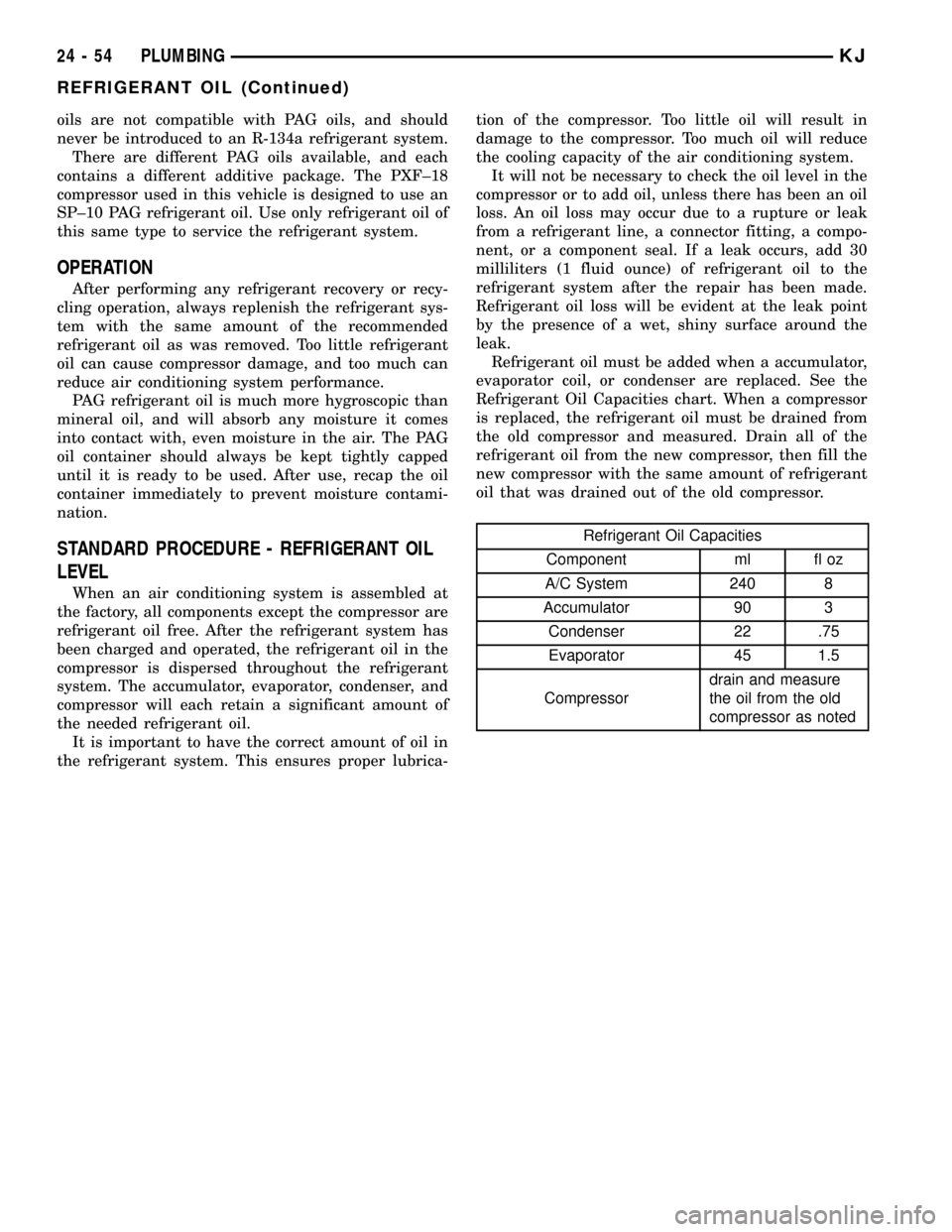2002 JEEP LIBERTY Accumulator
[x] Cancel search: AccumulatorPage 1700 of 1803

and the condenser outlet. Connect the liquid line to
the evaporator inlet and condenser outlet refrigerant
line couplers. (Refer to 24 - HEATING & AIR CON-
DITIONING/PLUMBING - STANDARD PROCE-
DURE - A/C LINE COUPLERS)
(2) Connect the battery negative cable.
(3) Evacuate the refrigerant system. (Refer to 24 -
HEATING & AIR CONDITIONING/PLUMBING -
STANDARD PROCEDURE - REFRIGERANT SYS-
TEM EVACUATE)
(4) Charge the refrigerant system. (Refer to 24 -
HEATING & AIR CONDITIONING/PLUMBING -
STANDARD PROCEDURE - REFRIGERANT SYS-
TEM CHARGE)
A/C SUCTION LINE
REMOVAL
WARNING: REVIEW THE WARNINGS AND CAU-
TIONS IN THE FRONT OF THIS SECTION BEFORE
PERFORMING THE FOLLOWING OPERATION.
(Refer to 24 - HEATING & AIR CONDITIONING/PLUMBING - WARNING) (Refer to 24 - HEATING &
AIR CONDITIONING/PLUMBING - CAUTION)
(1) Disconnect and isolate the negative battery
cable.
(2) Recover the refrigerant. (Refer to 24 - HEAT-
ING & AIR CONDITIONING/PLUMBING - STAN-
DARD PROCEDURE - REFRIGERANT RECOVERY)
(3) Unplug the wire harness connector from the a/c
high pressure switch (Fig. 9).
(4) Disconnect the discharge line refrigerant fitting
from the condenser inlet tube. (Refer to 24 - HEAT-
ING & AIR CONDITIONING/PLUMBING - STAN-
DARD PROCEDURE - A/C LINE COUPLERS)
Install plugs in, or tape over all of the opened refrig-
erant line fittings.
(5)
Remove the nut that secures the suction line
block fitting to the accumulator outlet. Install plugs in,
or tape over all of the opened refrigerant line fittings.
(6)Remove the fastener that secures the suction and
discharge line manifold to the compressor. Install plugs
in, or tape over all of the opened refrigerant line fit-
tings.
Fig. 8 LIQUID LINE REMOVE/INSTALL
1 - AC Condensor
2- AC condensor connector ports
3- Liquid line to condensor connector
4- Mounting nut
5- Liquid line
6- Liquid line mounting clips (2)
7- Mounting nut
8- Liquid line to evaporator connection
9- Evaporator connection
Fig. 9 SUCTION AND DISCHARGE LINE REMOVAL
1 - Condensor connection
2- Discharge line to condensor mounting nut
3- Discharge line
4- Discharge line charging port
5- Suction line
6- Evaporator mounting ports
7- Accumulator
8- High pressure cut off switch
9- AC compressor
10- AC condensor
24 - 48 PLUMBINGKJ
A/C LIQUID LINE (Continued)
Page 1701 of 1803

(7) Remove the suction and discharge line assem-
bly from the vehicle.
INSTALLATION
WARNING: REVIEW THE WARNINGS AND CAU-
TIONS IN THE FRONT IF THIS SECTION BEFORE
PERFORMING THE FOLLOWING OPERATION.
(Refer to 24 - HEATING & AIR CONDITIONING/
PLUMBING - WARNING) (Refer to 24 - HEATING &
AIR CONDITIONING/PLUMBING - CAUTION) (Refer
to 24 - HEATING & AIR CONDITIONING/PLUMBING -
CAUTION - REFRIGERANT HOSES/LINES/TUBES
PRECAUTIONS)
(1) Remove the tape or plugs from the suction and
discharge line manifold and the compressor. Install
the suction and discharge line manifold to the com-
pressor. Tighten the fastener to 28 N´m (250 in. lbs.).
(2) Remove the tape or plugs from the suction line
and the accumulator outlet block fittings. Install the
suction line to the accumulator outlet and tighten the
mounting nut to 9 N´m (80 in. lbs.).
(3) Remove the tape or plugs from the refrigerant
line fittings on the discharge line and the condenser
inlet tube. Connect the discharge line refrigerant line
coupler to the condenser inlet tube. (Refer to 24 -
HEATING & AIR CONDITIONING/PLUMBING -
STANDARD PROCEDURE - A/C LINE COUPLERS)
(4) Plug in the wire harness connector on the a/c
high pressure switch.
(5) Connect the battery negative cable.
(6) Evacuate the refrigerant system. (Refer to 24 -
HEATING & AIR CONDITIONING/PLUMBING -
STANDARD PROCEDURE - REFRIGERANT SYS-
TEM EVACUATE)
(7) Charge the refrigerant system. (Refer to 24 -
HEATING & AIR CONDITIONING/PLUMBING -
STANDARD PROCEDURE - REFRIGERANT SYS-
TEM CHARGE)
(8) Check the affected areas of the system for
leaks.
A/C EVAPORATOR
DESCRIPTION
The evaporator coil is located in the HVAC hous-
ing, under the instrument panel. The evaporator coil
is positioned in the HVAC housing so that all air that
enters the housing must pass over the fins of the
evaporator before it is distributed through the sys-
tem ducts and outlets. However, air passing over the
evaporator coil fins will only be conditioned when the
compressor is engaged and circulating refrigerant
through the evaporator coil tubes.
OPERATION
Refrigerant enters the evaporator from the fixed
orifice tube as a low-temperature, low-pressure liq-
uid. As air flows over the fins of the evaporator, the
humidity in the air condenses on the fins, and the
heat from the air is absorbed by the refrigerant. Heat
absorption causes the refrigerant to boil and vapor-
ize. The refrigerant becomes a low-pressure gas when
it leaves the evaporator.
The evaporator coil cannot be repaired and, if
faulty or damaged, it must be replaced.
REMOVAL
WARNING: ON VEHICLES EQUIPPED WITH AIR-
BAGS, DISABLE THE AIRBAG SYSTEM BEFORE
ATTEMPTING ANY STEERING WHEEL, STEERING
COLUMN, OR INSTRUMENT PANEL COMPONENT
DIAGNOSIS OR SERVICE. DISCONNECT AND ISO-
LATE THE BATTERY NEGATIVE (GROUND) CABLE,
THEN WAIT TWO MINUTES FOR THE AIRBAG SYS-
TEM CAPACITOR TO DISCHARGE BEFORE PER-
FORMING FURTHER DIAGNOSIS OR SERVICE. THIS
IS THE ONLY SURE WAY TO DISABLE THE AIRBAG
SYSTEM. FAILURE TO TAKE THE PROPER PRE-
CAUTIONS COULD RESULT IN AN ACCIDENTAL
AIRBAG DEPLOYMENT AND POSSIBLE PERSONAL
INJURY.
WARNING: REVIEW THE WARNINGS AND CAU-
TIONS IN THE FRONT OF THIS SECTION BEFORE
PERFORMING THE FOLLOWING OPERATION.
(Refer to 24 - HEATING & AIR CONDITIONING/
PLUMBING - WARNING) (Refer to 24 - HEATING &
AIR CONDITIONING/PLUMBING - CAUTION)
(1) Remove and disassemble the HVAC housing.
(Refer to 24 - HEATING & AIR CONDITIONING/
DISTRIBUTION/HVAC HOUSING - REMOVAL)
(Refer to 24 - HEATING & AIR CONDITIONING/
DISTRIBUTION/HVAC HOUSING - DISASSEMBLY)
(2) Lift the evaporator coil unit out of the lower
half of the HVAC housing. (Fig. 10).
INSTALLATION
WARNING: REVIEW THE WARNINGS AND CAU-
TIONS IN THE FRONT OF THIS SECTION BEFORE
PERFORMING THE FOLLOWING OPERATION.
(Refer to 24 - HEATING & AIR CONDITIONING/
PLUMBING - WARNING) (Refer to 24 - HEATING &
AIR CONDITIONING/PLUMBING - CAUTION) (Refer
to 24 - HEATING & AIR CONDITIONING/PLUMBING -
CAUTION - REFRIGERANT HOSES/LINES/TUBES
PRECAUTIONS)
KJPLUMBING 24 - 49
A/C SUCTION LINE (Continued)
Page 1703 of 1803

replaced. (Refer to 24 - HEATING & AIR CONDI-
TIONING/PLUMBING/LIQUID LINE - REMOVAL)
ACCUMULATOR
DESCRIPTION
The accumulator is mounted in the engine com-
partment between the evaporator coil outlet tube and
the compressor inlet.
OPERATION
Refrigerant enters the accumulator canister as a
low pressure vapor through the inlet tube. Any liq-
uid, oil-laden refrigerant falls to the bottom of the
canister, which acts as a separator. A desiccant bag is
mounted inside the accumulator canister to absorb
any moisture which may have entered and become
trapped within the refrigerant system (Fig. 12).
REMOVAL
WARNING: REVIEW THE WARNINGS AND CAU-
TIONS IN THE FRONT OF THIS SECTION BEFORE
PERFORMING THE FOLLOWING OPERATION.
(Refer to 24 - HEATING & AIR CONDITIONING/
PLUMBING - WARNING) (Refer to 24 - HEATING &
AIR CONDITIONING/PLUMBING - CAUTION)
(1) Disconnect and isolate the battery negative
cable.
(2) Recover the refrigerant from the refrigerant
system. (Refer to 24 - HEATING & AIR CONDI-
TIONING/PLUMBING - STANDARD PROCEDURE -
REFRIGERANT RECOVERY)
(3) Unplug the wire harness connector from the
low pressure cycling clutch switch.
(4) Loosen the screw that secures the accumulator
retaining band to the support bracket on the dash
panel (Fig. 13).
(5) Disconnect the suction line from the accumula-
tor outlet tube refrigerant line fitting. (Refer to 24 -
HEATING & AIR CONDITIONING/PLUMBING -
STANDARD PROCEDURE - A/C LINE COUPLERS)
Install plugs in, or tape over all of the opened refrig-
erant line fittings.
(6) Disconnect the accumulator inlet tube refriger-
ant line fitting from the evaporator outlet tube.
(Refer to 24 - HEATING & AIR CONDITIONING/
PLUMBING - STANDARD PROCEDURE - A/C LINE
COUPLERS) Install plugs in, or tape over all of the
opened refrigerant line fittings.
(7) Pull the accumulator and retaining band unit
forward until the screw in the band is clear of the
slotted hole in the support bracket on the dash panel.
(8) Remove the accumulator from the vehicle.
INSTALLATION
WARNING: REVIEW THE WARNINGS AND CAU-
TIONS IN THE FRONT OF THIS SECTION BEFORE
PERFORMING THE FOLLOWING OPERATION.
(Refer to 24 - HEATING & AIR CONDITIONING/
PLUMBING - WARNING) (Refer to 24 - HEATING &
AIR CONDITIONING/PLUMBING - CAUTION) (Refer
to 24 - HEATING & AIR CONDITIONING/PLUMBING -
CAUTION - REFRIGERANT HOSES/LINES/TUBES
PRECAUTIONS)
(1) Install the accumulator and retaining band as
a unit by sliding the screw in the band into the slot-
ted hole in the support bracket on the dash panel.
(2) Remove the tape or plugs from the refrigerant
line fittings on the accumulator inlet tube and the
Fig. 12 ACCUMULATOR - TYPICAL
1 - A/C LOW PRESSURE SWITCH
2 - PRESSURE SWITCH FITTING
3 - OUTLET TO COMPRESSOR
4 - ANTI-SIPHON HOLE
5 - DESICCANT BAG
6 - OIL RETURN ORIFICE FILTER
7 - VAPOR RETURN TUBE
8 - ACCUMULATOR DOME
9 - O-RING SEAL
10 - INLET FROM EVAPORATOR
KJPLUMBING 24 - 51
A/C ORIFICE TUBE (Continued)
Page 1704 of 1803

evaporator outlet tube. Connect the accumulator inlet
tube refrigerant line coupler to the evaporator outlet
tube. (Refer to 24 - HEATING & AIR CONDITION-
ING/PLUMBING - STANDARD PROCEDURE - A/C
LINE COUPLERS)
(3) Tighten the accumulator retaining band screw
to 5 N´m (45 in. lbs.).
(4) Remove the tape or plugs from the refrigerant
line fittings on the suction line and the accumulator
outlet tube. Connect the suction line to the accumu-
lator outlet tube refrigerant line coupler. (Refer to 24
- HEATING & AIR CONDITIONING/PLUMBING -
STANDARD PROCEDURE - A/C LINE COUPLERS)
(5) Plug the wire harness connector into the low
pressure cycling clutch switch.
(6) Connect the battery negative cable.
(7) Evacuate the refrigerant system. (Refer to 24 -
HEATING & AIR CONDITIONING/PLUMBING -
STANDARD PROCEDURE - REFRIGERANT SYS-
TEM EVACUATE)
(8) Charge the refrigerant system. (Refer to 24 -
HEATING & AIR CONDITIONING/PLUMBING -
STANDARD PROCEDURE - REFRIGERANT SYS-
TEM CHARGE)NOTE: If the accumulator is replaced, add 120 mil-
liliters (4 fluid ounces) of refrigerant oil to the
refrigerant system. Use only refrigerant oil of the
type recommended for the compressor in the vehi-
cle. (Refer to 24 - HEATING & AIR CONDITIONING/
PLUMBING/REFRIGERANT OIL - DESCRIPTION)
HEATER CORE
DESCRIPTION
The heater core is located in the HVAC housing,
under the instrument panel. It is a heat exchanger
made of rows of tubes and fins and uses warm engine
coolant as its heat source.
OPERATION
Engine coolant is circulated through heater hoses
to the heater core at all times. As the coolant flows
through the heater core, heat removed from the
engine is transferred to the heater core fins and
tubes. Air directed through the heater core picks up
the heat from the heater core fins. The temperature
control door allows control of the heater output air
temperature by controlling how much of the air flow-
ing through the HVAC housing is directed through
the heater core. The blower motor speed controls the
volume of air flowing through the HVAC housing.
The heater core cannot be repaired and, if faulty or
damaged, it must be replaced. Refer to Cooling for
more information on the engine cooling system, the
engine coolant and the heater hoses.
REMOVAL
WARNING: ON VEHICLES EQUIPPED WITH AIR-
BAGS, DISABLE THE AIRBAG SYSTEM BEFORE
ATTEMPTING ANY STEERING WHEEL, STEERING
COLUMN, OR INSTRUMENT PANEL COMPONENT
DIAGNOSIS OR SERVICE. DISCONNECT AND ISO-
LATE THE BATTERY NEGATIVE (GROUND) CABLE,
THEN WAIT TWO MINUTES FOR THE AIRBAG SYS-
TEM CAPACITOR TO DISCHARGE BEFORE PER-
FORMING FURTHER DIAGNOSIS OR SERVICE. THIS
IS THE ONLY SURE WAY TO DISABLE THE AIRBAG
SYSTEM. FAILURE TO TAKE THE PROPER PRE-
CAUTIONS COULD RESULT IN AN ACCIDENTAL
AIRBAG DEPLOYMENT AND POSSIBLE PERSONAL
INJURY.
Fig. 13 A/C LOW PRESSURE SWITCH
1 - WIRING HARNESS CONNECTOR
2 - A/C LOW PRESSURE SWITCH
3 - A/C LINE TO EVAPORATOR
4 - ACCUMULATOR MOUNTING BRACKET
5 - ACCUMULATOR
6 - A/C LOW PRESSURE LINE
24 - 52 PLUMBINGKJ
ACCUMULATOR (Continued)
Page 1706 of 1803

oils are not compatible with PAG oils, and should
never be introduced to an R-134a refrigerant system.
There are different PAG oils available, and each
contains a different additive package. The PXF±18
compressor used in this vehicle is designed to use an
SP±10 PAG refrigerant oil. Use only refrigerant oil of
this same type to service the refrigerant system.
OPERATION
After performing any refrigerant recovery or recy-
cling operation, always replenish the refrigerant sys-
tem with the same amount of the recommended
refrigerant oil as was removed. Too little refrigerant
oil can cause compressor damage, and too much can
reduce air conditioning system performance.
PAG refrigerant oil is much more hygroscopic than
mineral oil, and will absorb any moisture it comes
into contact with, even moisture in the air. The PAG
oil container should always be kept tightly capped
until it is ready to be used. After use, recap the oil
container immediately to prevent moisture contami-
nation.
STANDARD PROCEDURE - REFRIGERANT OIL
LEVEL
When an air conditioning system is assembled at
the factory, all components except the compressor are
refrigerant oil free. After the refrigerant system has
been charged and operated, the refrigerant oil in the
compressor is dispersed throughout the refrigerant
system. The accumulator, evaporator, condenser, and
compressor will each retain a significant amount of
the needed refrigerant oil.
It is important to have the correct amount of oil in
the refrigerant system. This ensures proper lubrica-tion of the compressor. Too little oil will result in
damage to the compressor. Too much oil will reduce
the cooling capacity of the air conditioning system.
It will not be necessary to check the oil level in the
compressor or to add oil, unless there has been an oil
loss. An oil loss may occur due to a rupture or leak
from a refrigerant line, a connector fitting, a compo-
nent, or a component seal. If a leak occurs, add 30
milliliters (1 fluid ounce) of refrigerant oil to the
refrigerant system after the repair has been made.
Refrigerant oil loss will be evident at the leak point
by the presence of a wet, shiny surface around the
leak.
Refrigerant oil must be added when a accumulator,
evaporator coil, or condenser are replaced. See the
Refrigerant Oil Capacities chart. When a compressor
is replaced, the refrigerant oil must be drained from
the old compressor and measured. Drain all of the
refrigerant oil from the new compressor, then fill the
new compressor with the same amount of refrigerant
oil that was drained out of the old compressor.
Refrigerant Oil Capacities
Component ml fl oz
A/C System 240 8
Accumulator 90 3
Condenser 22 .75
Evaporator 45 1.5
Compressordrain and measure
the oil from the old
compressor as noted
24 - 54 PLUMBINGKJ
REFRIGERANT OIL (Continued)
Page 1740 of 1803

ABS - DESCRIPTION, BRAKES...........5-32
ABS - OPERATION, BRAKES.............5-32
ABS - SPECIFICATIONS, BRAKES.........5-33
ABS BRAKE BLEEDING - STANDARD
PROCEDURE.........................5-33
ABS INDICATOR - DESCRIPTION.........8J-11
ABS INDICATOR - OPERATION..........8J-11
A/C APPLICATION TABLE,
SPECIFICATIONS......................24-9
A/C COMPRESSOR CLUTCH -
INSPECTION........................24-14
A/C COMPRESSOR CLUTCH -
INSTALLATION.......................24-14
A/C COMPRESSOR CLUTCH - REMOVAL . . 24-13
A/C COMPRESSOR CLUTCH BREAK-IN -
STANDARD PROCEDURE...............24-12
A/C COMPRESSOR CLUTCH COIL -
DIAGNOSIS AND TESTING.............24-12
A/C COMPRESSOR CLUTCH RELAY -
DESCRIPTION.......................24-15
A/C COMPRESSOR CLUTCH RELAY -
INSTALLATION.......................24-16
A/C COMPRESSOR CLUTCH RELAY -
OPERATION.........................24-15
A/C COMPRESSOR CLUTCH RELAY -
REMOVAL..........................24-16
A/C COMPRESSOR NOISE - DIAGNOSIS
AND TESTING.......................24-42
A/C CONDENSER - DESCRIPTION........24-45
A/C CONDENSER - INSTALLATION.......24-46
A/C CONDENSER - OPERATION...........24-45
A/C CONDENSER - REMOVAL...........24-45
A/C DISCHARGE LINE - INSTALLATION . . . 24-47
A/C DISCHARGE LINE - REMOVAL.......24-46
A/C EVAPORATOR - DESCRIPTION.......24-49
A/C EVAPORATOR - INSTALLATION......24-49
A/C EVAPORATOR - OPERATION.........24-49
A/C EVAPORATOR - REMOVAL..........24-49
A/C HEATER CONTROL - DESCRIPTION . . . 24-16
A/C HEATER CONTROL - INSTALLATION . . . 24-17
A/C HEATER CONTROL - REMOVAL......24-17
A/C HIGH PRESSURE SWITCH -
DESCRIPTION.......................24-17
A/C HIGH PRESSURE SWITCH -
DIAGNOSIS AND TESTING.............24-18
A/C HIGH PRESSURE SWITCH -
INSTALLATION.......................24-18
A/C HIGH PRESSURE SWITCH -
OPERATION.........................24-18
A/C HIGH PRESSURE SWITCH -
REMOVAL..........................24-18
A/C LIQUID LINE - INSTALLATION.......24-47
A/C LIQUID LINE - REMOVAL...........24-47
A/C LOW PRESSURE SWITCH -
DESCRIPTION.......................24-18
A/C LOW PRESSURE SWITCH -
DIAGNOSIS AND TESTING.............24-19
A/C LOW PRESSURE SWITCH -
INSTALLATION.......................24-19
A/C LOW PRESSURE SWITCH -
OPERATION.........................24-18
A/C LOW PRESSURE SWITCH -
REMOVAL..........................24-19
A/C ORIFICE TUBE - DESCRIPTION.......24-50
A/C ORIFICE TUBE - INSTALLATION......24-50
A/C ORIFICE TUBE - OPERATION........24-50
A/C ORIFICE TUBE - REMOVAL..........24-50
A/C PERFORMANCE - DIAGNOSIS AND
TESTING............................24-2
A/C SUCTION LINE - INSTALLATION......24-49
A/C SUCTION LINE - REMOVAL.........24-48
ACCELERATOR PEDAL - INSTALLATION . . . 14-30
ACCELERATOR PEDAL - REMOVAL.......14-29
ACCESS PANEL - DESCRIPTION, LATCH . . 23-139
ACCESS PANEL - INSTALLATION, LATCH . 23-139
ACCESS PANEL - REMOVAL, LATCH.....23-139
ACCUMULATOR - DESCRIPTION.........24-51
ACCUMULATOR - INSTALLATION........24-51
ACCUMULATOR - OPERATION..........24-51
ACCUMULATOR - REMOVAL
............24-51
ACTUATION TEST MODE - DESCRIPTION,
CIRCUIT
.............................25-2
ACTUATOR - INSTALLATION, BLEND
DOOR
.............................24-20
ACTUATOR - INSTALLATION, FLOOR -
DEFROST DOOR
.....................24-25
ACTUATOR - INSTALLATION, PANEL
DOOR
.............................24-25ACTUATOR - INSTALLATION,
RECIRCULATION DOOR................24-26
ACTUATOR - REMOVAL, BLEND DOOR....24-20
ACTUATOR - REMOVAL, FLOOR -
DEFROST DOOR.....................24-24
ACTUATOR - REMOVAL, PANEL DOOR....24-24
ACTUATOR - REMOVAL, RECIRCULATION
DOOR.............................24-26
ADAPTER - INSTALLATION, DISC BRAKE
CALIPER............................5-18
ADAPTER - REMOVAL, DISC BRAKE
CALIPER............................5-18
ADAPTER HOUSING SEAL -
INSTALLATION......................21-124
ADAPTER HOUSING SEAL - REMOVAL . . . 21-124
ADAPTOR - REMOVAL, DEFROST
DUCT/DEMISTER.....................24-32
ADHESIVE LOCATIONS -
SPECIFICATIONS, WELD AND
STRUCTURAL........................23-9
ADJUSTER - DIAGNOSIS AND TESTING,
HYDRAULIC LASH.................9-19,9-30
ADJUSTER - INSTALLATION, SEAT BELT
TURNING LOOP.....................8O-38
ADJUSTER - REMOVAL, SEAT BELT
TURNING LOOP.....................8O-37
ADJUSTMENT - STANDARD
PROCEDURE, CAMBER AND CASTER.......2-5
ADJUSTMENT - STANDARD
PROCEDURE, CAMBER, CASTER AND
TOE .................................2-5
ADJUSTMENT - STANDARD
PROCEDURE, COMPASS VARIATION......8M-3
ADJUSTMENT - STANDARD
PROCEDURE, TOE......................2-5
ADJUSTMENT, ADJUSTMENTS . . . 23-119,23-124,
23-131
ADJUSTMENT, ADJUSTMENTS...........3-55
ADJUSTMENT, ADJUSTMENTS -
SUNROOF GLASS PANEL.............23-178
ADJUSTMENT, FRONT FOG LAMP UNIT . . . 8L-25
ADJUSTMENT, HEADLAMP UNIT.........8L-42
ADJUSTMENT, LOCK OUT...............5-30
ADJUSTMENT, REAR DRUM BRAKE.......5-12
ADJUSTMENTS - ADJUSTMENT . . 23-119,23-124,
23-131
ADJUSTMENTS - ADJUSTMENT..........3-55
ADJUSTMENTS - SUNROOF GLASS
PANEL ADJUSTMENT................23-178
ADJUSTMENTS, FRONT AXLE - 186FIA....3-25
ADJUSTMENTS, GEARSHIFT CABLE.....21-130
ADJUSTMENTS, PARK-INTERLOCK
CABLE............................21-154
ADJUSTMENTS, REAR AXLE - 8 1/4 .......3-92
AFTER A SUPPLEMENTAL RESTRAINT
DEPLOYMENT - STANDARD
PROCEDURE, SERVICE.................8O-6
AIR CHECKING TRANSMISSION CLUTCH
OPERATION - DIAGNOSIS AND
TESTING...........................21-80
AIR CONDITIONER - DESCRIPTION,
HEATER .............................24-1
AIR CONDITIONER - OPERATION,
HEATER .............................24-2
AIR CONTROL MOTOR - DESCRIPTION,
IDLE...............................14-35
AIR CONTROL MOTOR - INSTALLATION,
IDLE...............................14-36
AIR CONTROL MOTOR - OPERATION,
IDLE...............................14-35
AIR CONTROL MOTOR - REMOVAL, IDLE . . 14-36
AIR TEMPERATURE SENSOR -
DESCRIPTION, INTAKE................14-36
AIR TEMPERATURE SENSOR -
INSTALLATION, INTAKE................14-38
AIR TEMPERATURE SENSOR -
OPERATION, INTAKE..................14-36
AIR TEMPERATURE SENSOR -
REMOVAL, INTAKE...................14-37
AIRBAG - DESCRIPTION, DRIVER........8O-17
AIRBAG - DESCRIPTION, PASSENGER....8O-27
AIRBAG - DESCRIPTION, SIDE CURTAIN . . 8O-38
AIRBAG - INSTALLATION, DRIVER.......8O-20
AIRBAG - INSTALLATION, PASSENGER
. . . 8O-29
AIRBAG - INSTALLATION, SIDE CURTAIN
. . 8O-41
AIRBAG - OPERATION, DRIVER
.........8O-18
AIRBAG - OPERATION, PASSENGER
......8O-27
AIRBAG - OPERATION, SIDE CURTAIN
....8O-39AIRBAG - REMOVAL, DRIVER...........8O-19
AIRBAG - REMOVAL, PASSENGER.......8O-28
AIRBAG - REMOVAL, SIDE CURTAIN.....8O-40
AIRBAG CONTROL MODULE -
DESCRIPTION........................8O-9
AIRBAG CONTROL MODULE -
DESCRIPTION, SIDE IMPACT...........8O-43
AIRBAG CONTROL MODULE -
INSTALLATION......................8O-12
AIRBAG CONTROL MODULE -
INSTALLATION, SIDE IMPACT...........8O-45
AIRBAG CONTROL MODULE -
OPERATION.........................8O-10
AIRBAG CONTROL MODULE -
OPERATION, SIDE IMPACT.............8O-43
AIRBAG CONTROL MODULE - REMOVAL . . 8O-11
AIRBAG CONTROL MODULE - REMOVAL,
SIDE IMPACT.......................8O-44
AIRBAG DOOR - INSTALLATION,
PASSENGER........................8O-30
AIRBAG DOOR - REMOVAL, PASSENGER . . 8O-29
AIRBAG INDICATOR - DESCRIPTION......8J-12
AIRBAG INDICATOR - OPERATION.......8J-12
AIRBAG MOUNTING BRACKET -
INSTALLATION, PASSENGER...........8O-31
AIRBAG MOUNTING BRACKET -
REMOVAL, PASSENGER...............8O-31
AJAR INDICATOR - DESCRIPTION, DOOR . . 8J-17
AJAR INDICATOR - DESCRIPTION, GATE . . 8J-20
AJAR INDICATOR - DESCRIPTION,
GLASS..............................8J-21
AJAR INDICATOR - OPERATION, DOOR . . . 8J-17
AJAR INDICATOR - OPERATION, GATE....8J-20
AJAR INDICATOR - OPERATION, GLASS . . . 8J-21
AJAR SWITCH - DESCRIPTION, DOOR....8L-77
AJAR SWITCH - DESCRIPTION, FLIP-UP
GLASS.............................8L-77
AJAR SWITCH - DESCRIPTION, HOOD....8Q-11
AJAR SWITCH - DESCRIPTION,
TAILGATE...........................8L-82
AJAR SWITCH - DIAGNOSIS AND
TESTING, HOOD.....................8Q-12
AJAR SWITCH - INSTALLATION, HOOD . . . 8Q-12
AJAR SWITCH - OPERATION, DOOR......8L-77
AJAR SWITCH - OPERATION, FLIP-UP
GLASS.............................8L-77
AJAR SWITCH - OPERATION, HOOD.....8Q-12
AJAR SWITCH - OPERATION, TAILGATE . . . 8L-82
AJAR SWITCH - REMOVAL, HOOD.......8Q-12
AJAR SWITCH BRACKET -
INSTALLATION, HOOD.................8Q-13
AJAR SWITCH BRACKET - REMOVAL,
HOOD.............................8Q-13
AJAR SWITCH STRIKER -
INSTALLATION, HOOD.................8Q-14
AJAR SWITCH STRIKER - REMOVAL,
HOOD.............................8Q-13
ALIGNMENT - DESCRIPTION, WHEEL.......2-3
ALIGNMENT - OPERATION, WHEEL........2-3
ALIGNMENT, SPECIFICATIONS............2-6
ALUMINUM THREAD REPAIR -
STANDARD PROCEDURE...............21-81
AMBIENT TEMP SENSOR - DESCRIPTION . . 8M-9
AMBIENT TEMP SENSOR - OPERATION . . . 8M-9
AMBIENT TEMPERATURE SENSOR -
DIAGNOSIS AND TESTING..............8M-9
AMBIENT TEMPERATURE SENSOR
CIRCUIT - DIAGNOSIS AND TESTING.....8M-9
AMPERAGE TEST - DIAGNOSIS AND
TESTING, FUEL PUMP.................14-16
AMPLIFIER CHOKE AND RELAY -
DESCRIPTION........................8A-3
AMPLIFIER CHOKE AND RELAY -
DIAGNOSIS AND TESTING..............8A-4
AMPLIFIER CHOKE AND RELAY -
INSTALLATION.......................8A-4
AMPLIFIER CHOKE AND RELAY -
OPERATION..........................8A-3
AMPLIFIER CHOKE AND RELAY -
REMOVAL...........................8A-4
ANCHOR - DESCRIPTION, CHILD TETHER
. 8O-13
ANCHOR - OPERATION, CHILD TETHER
. . . 8O-13
ANGLE - STANDARD PROCEDURES,
PROPELLER SHAFT
.....................3-3
ANTENNA BODY & CABLE -
DESCRIPTION
........................8A-4
ANTENNA BODY & CABLE -
INSTALLATION
.......................8A-6
KJINDEX 1
Description Group-Page Description Group-Page Description Group-Page